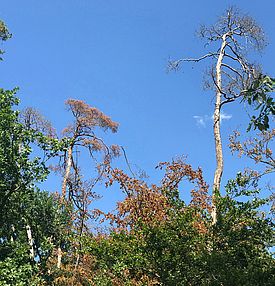17.01.2018 | Reinhard Lässig | News WSL
If it gets warmer, trees evaporate more water. The fact that they suffer under drought stress and produce less wood as a result is shown by a study based on worldwide data by the Swiss Federal Research Institute WSL in the magazine Science Advances. The further away trees grow from the poles or mountain peaks, the more the lack of precipitation limits their growth.

The tree rings of the trees show how climate fluctuations affect tree growth. This is because trees react above all to that climate factor which is most limiting to their tree ring growth. If, for example, it is cold (as in the high altitudes of the Alps, the Himalayas or northern Scandinavia), the temperature limits wood growth. However, where it is warm and dry (as in Ticino, Valais, southern Spain or Mexico), the growth reacts primarily to precipitation and the trees stop growing prematurely during intense drought.
WSL scientists, together with research institutions from Canada, Poland, Romania and the USA, have for the first time analysed a large amount of tree ring data from trees in 2710 locations worldwide, representing about 70% of the global forest area in terms of climate conditions. At each of the sites, especially in North America and Europe, but also in Russia, Central Asia, New Zealand, Argentina and Chile (see Figure 1), the researchers correlated tree growth with seasonal climate fluctuations during a period of the early (1930-1960) and late 20th century (1960-1990).
Major droughts in the northernmost forests
A comparison of the annual ring growth in the two periods shows that trees almost everywhere in the world suffered more from drought in the later period than in the earlier one. The area where tree growth is limited by cold temperature has become significantly smaller worldwide from the early to the late period. Figure 1 shows that this occurs mainly in the boreal zone of Eurasia and North America as well as in the high altitudes of the great mountain massifs in the Alps, Patagonia and Tibet. There the warming was above average, while the amount of precipitation changed only insignificantly. Therefore, the trees evaporated more water, the soil and the air became drier and more dry periods occurred. It can be assumed that the trend towards warming will continue in these regions and in the boreal zone as well.
Increasing consequences of water shortage
Climate impact research shows that global warming in the 20th century was much lower than what is being predicted for the 21st century. "If it is already evident in the 20th century that trees are increasingly suffering from water shortages, it is very likely that such phenomena will occur much more often and severely in the 21st century," says Flurin Babst, the first author of the study. Researchers therefore expect that in the coming decades trees will be exposed to large-scale stress situations if precipitation remains constant: "Trees will probably be regularly exposed to dry periods far into the north, up to 60 degrees latitude," says Babst.
The findings of this global study are relevant for Switzerland, where the climate changes primarily with increasing sea level. In future, the annual growth of trees in the Alps will probably be less and less controlled by temperature. Drought will increasingly limit tree growth, especially in the valleys. Current examples from Switzerland:
- Scots pine: In the Lower Valais, trees of this species have increasingly been dying for 20 years. The Valais belongs to the southernmost part of its distribution area.
- Beech: In summer 2018, the leaves of numerous Beech trees turned brown very early, especially in northern and northwestern Switzerland, but also in neighbouring countries. In the best case, the leaves only dried out earlier than usual, so that they did not evaporate as much water as in the previous weeks; in the worst case, beech trees died.
- Spruce: Switzerland's most frequent tree species is increasingly suffering from water stress in the Central Plateau. This makes it attractive for bark beetles. In the summer of 2018, the consequences of beetle attack led to the premature death of many of these conifers.
Numerous countries, including Switzerland, have committed themselves to CO2 reduction in the Paris Climate Convention. In this context, forests are important for storing CO2. This is because the fixation of carbon in the form of wood counteracts man-made emissions. Moreover, foresters and forest owners in Switzerland will have to consider how to manage and maintain their forests in the future so that they remain resilient and can be utilized sustainably even under warmer and drier conditions.
Publications ¶
Copyright ¶
WSL and SLF provide image and sound material free of charge for use in the context of press contributions in connection with this media release. The transfer of this material to image, sound and/or video databases and the sale of the material by third parties are not permitted.

